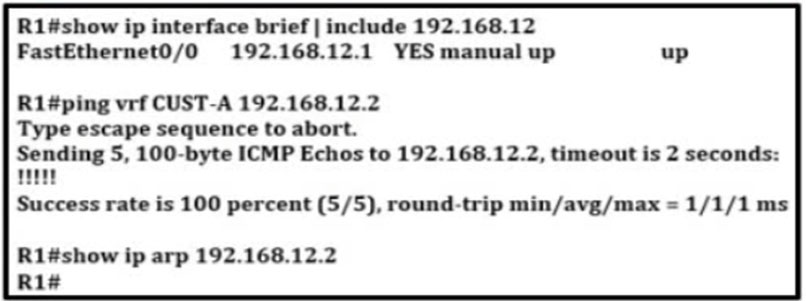
Refer to the exhibit. A network engineer checks connectivity between two routers. The engineer can ping the remote endpoint but cannot see an ARP entry. Why is there no ARP entry?

Refer to the exhibit. A network engineer checks connectivity between two routers. The engineer can ping the remote endpoint but cannot see an ARP entry. Why is there no ARP entry?
The lack of an ARP entry is explained by the configuration of Interface FastEthernet0/0 in VRF CUST-A. When an interface is a part of a VRF, the ARP entries are maintained within that VRF. This is why the ARP entry is not visible in the global context but exists in the VRF context. The connectivity test using the ping command through the VRF CUST-A targets another endpoint within the same VRF, demonstrating successful ping results but isolating the ARP entry within that VRF, making it invisible in the global ARP table.
cisco#show ip arp vrf ? WORD VPN Routing/Forwarding instance name cisco#show ip arp vrf
cisco_R3#show ip arp vrf cust_1 Protocol Address Age (min) Hardware Addr Type Interface Internet 192.168.1.1 - aabb.cc00.3000 ARPA Ethernet0/0.20 Internet 192.168.1.200 - aabb.cc00.3000 ARPA Ethernet0/0.20 cisco_R3#
LOL - C is correct
C is correct
the ping command musty be executed from the global routing table. if interface fa0/0 was in vrf then it wouldn't be shown with the command "show ip int brief", it would have been shown if the command included "vrf XXX" or "vrf all". now that means that one IP is in the global and 1 IP is in the vrf. specifically the .2 is in the vrf, thats why you dont see the arp in the global routing table or adjacency table to be more accurate. if the ping was from the grt then there would also be arp if properley connected
I haven't researched it, but that is true for NX-OS, but not for IOS, as far as I know. For IOS, "show ip interfaces brief" shows all interfaces where an IP is assigned regardless of the VRF forwarding configured or not configured under it.